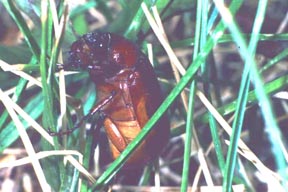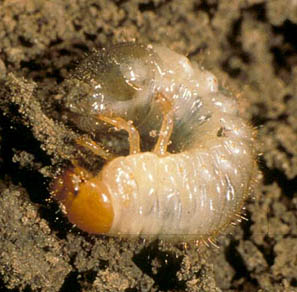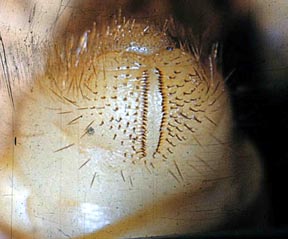May Beetles | |
|---|---|
| June 2, 2008 | |
|
Adult May beetles are present throughout the state. These are 1-inch long, stocky beetles that are active at night. Many species occur in Illinois, all in the scarab genus, Phyllophaga. As such, they vary in color and somewhat in size, being some shade of brown, from tan through dark chocolate brown. The ones that are out at this time are reddish brown. These insects emerged from the pupal stage last fall and spent the winter underground as adult beetles. These beetles are sometimes found when you are planting trees or tilling the soil in the fall and spring. As their name indicates, they emerge in May and are quite common, being strongly attracted to lights at night. They spend the day burrowed into the soil of turf areas, emerging at night to feed, mate, and lay eggs.  May beetle adults feed primarily on tree leaves, eating at leaf margins, sometimes to the midvein. Damaged leaves are commonly seen on crabapple, ash, oak, and other broad-leaved trees at this time of year. Damage can be puzzling because no insects are present during the day. They start to show up on the tree foliage at about dusk, and I have found them numerous times feeding in high numbers on the foliage at about 10:30 p.m. They are easily controlled with a spray of carbaryl (Sevin), various pyrethroids, and other labeled insecticides. Typically, most of these beetles are engaged in sex while the female continues to eat the tree foliage. Mated females fly to turf and other areas, burrowing down a couple of inches into the soil to lay their eggs. The larvae are known as true white grubs and have broad feeding habits.  The larvae feed on dead organic matter, as well as roots. It is common for them to be found in mulched areas, such as flower beds, where they typically cause no serious harm to the plants. They also feed on the roots of vegetables, including carrots, potatoes, and sweet potatoes. This is so common that it is recommended to avoid planting root vegetables for 3 years in new garden areas that were previously in turf. They also feed heavily on turfgrass roots, causing turf to wilt and turn brown, with the turf being easily pulled back like a carpet due to the loss of roots. Life cycles are quite varied, with this genus containing the 3-year white grub, named for the length of its life cycle; species with 3-year life cycle commonly take 4 or more years to complete their life cycles under adverse food or climate conditions. However, there are species that have 1- and 2-year life cycles. One common Phyllophaga species in southern Illinois has a 1-year life cycle and emerges as an adult at this time of year. Unlike most in the genus, the adult is tan and only about 1/2 inch long. Landscapers and other turf professionals see these beetles and think that the masked chafers have emerged early. Masked chafer adult beetles are named for their black face, which this true white grub species does not have. Eggs hatch 2 to 3 weeks after the beetles die off. Due to the adult beetlesí feeding on tree foliage, the adults are present for 3 to 4 weeks. The eggs hatch into white grubs that feed through the balance of the summer and are easily controlled in this first year with insecticides used to control annual white grub species, such as Japanese beetle and masked chafers. In the 3-year life cycle, larvae descend deeper into the soil to overwinter, rise to feed during the next growing season, descend into the soil to spend a second winter, and rise to feed during their third spring. They pupate and emerge as adults underground during this third growing season.  These second- and third-year true white grubs are commonly encountered by turf professionals as large individuals at times when Japanese beetle and masked chafer grubs should not be present or should still be small. It is important in these cases to check the raster pattern of the grub for identification. True white grub larvae have two parallel rows of thick hairs, or setae, on the underside of the last abdominal segment. They also tend to grow larger, with third-year larvae approaching 1-1/2 inches in length. True white grubs tend to survive better in drier soil conditions than do Japanese beetle and masked chafer grubs. For that reason, they frequently appear in nonirrigated turf that is commonly not treated for the annual-life-cycle grub species. Turf damage tends to be spotty because, although May beetle grubs can be found in small numbers in many turf areas, damaging numbers are uncommon. When turf damage does occur, the grubs are typically too large for effective control by typical grub insecticides. Insecticidal nematodes, particularly Heterorhabditis bacteriophora, provide the most effective control. | |
| Author: | Phil Nixon |
